Do Cardinals Eat Black Oil Sunflower Seeds for Feeding?
Cardinals consume black oil sunflower seeds extensively due to their high fat and protein content, which are crucial for their metabolic and nutritional needs. These seeds provide essential energy and nutrients, especially during periods of intense activity or adverse weather.
Cardinals also favor other seeds such as safflower, white millet, and cracked corn, and they adjust their diet seasonally to include fruits and insects. However, relying solely on black oil sunflower seeds could result in nutritional imbalances.
Proper feeder setup and food diversity are essential for peak health. Discover how to maintain a balanced diet and ideal feeding conditions for cardinals.
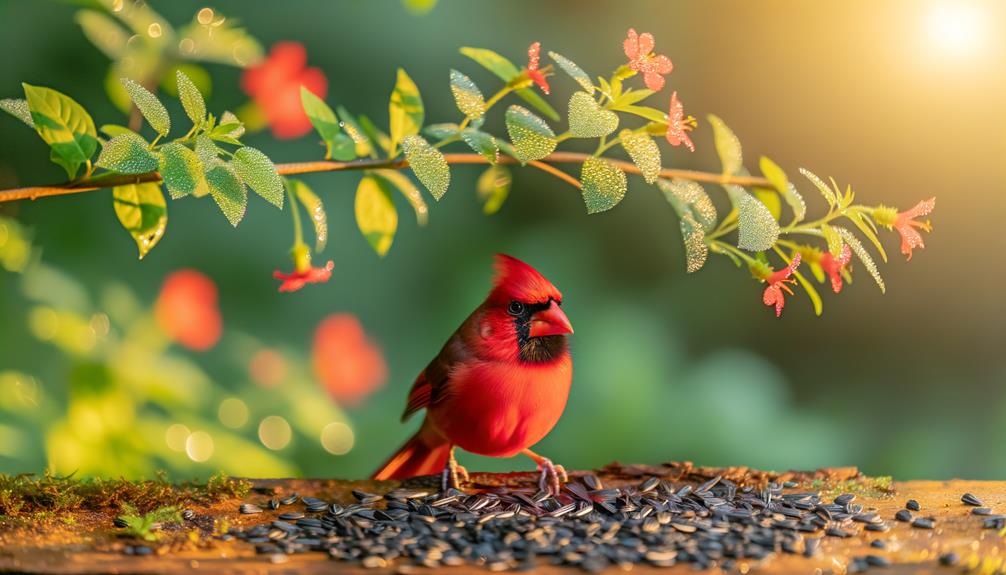
Key Takeaways
- Cardinals enjoy eating black oil sunflower seeds due to their high fat and protein content.
- Black oil sunflower seeds are a preferred food source for cardinals, especially in feeders.
- Cardinals benefit from the nutritional value of black oil sunflower seeds, but should not rely solely on them.
- Excessive consumption of black oil sunflower seeds can lead to nutritional imbalances and health issues in cardinals.
- Providing a variety of seeds and foods ensures a balanced diet and better overall health for cardinals.
Cardinal Dietary Preferences
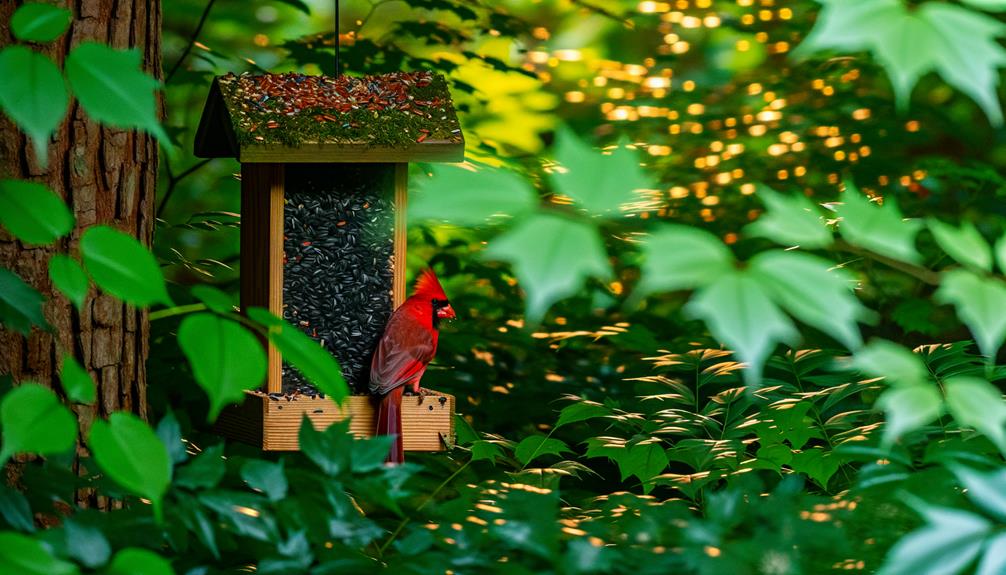
Cardinals exhibit a broad range of dietary preferences that encompass seeds, fruits, and small insects, making them omnivorous feeders in their natural habitats. This diverse diet allows them to adapt to various environments and seasonal availability of food sources. Seeds constitute a significant portion of their diet, with a particular affinity for those rich in oils, such as sunflower seeds.
They also consume various fruits, providing essential vitamins and hydration. Small insects, including beetles and caterpillars, are essential during breeding seasons, supplying necessary protein. This dietary versatility not only supports their nutritional requirements but also influences their foraging behavior and habitat selection.
Understanding these preferences is essential for creating effective conservation strategies and enhancing bird-feeding practices.
Nutritional Needs of Cardinals
Meeting the nutritional needs of cardinals requires a diet rich in proteins, fats, vitamins, and minerals to support their metabolic processes, reproductive health, and overall well-being.
Proteins are essential for muscle development and feather integrity, while fats provide necessary energy, particularly in colder climates where energy demands increase.
Vitamins such as A, D, and E play crucial roles in immune function, calcium metabolism, and antioxidant protection, respectively.
Minerals, including calcium and phosphorus, are vital for bone health and eggshell formation.
Additionally, a balance of carotenoids, obtained from various natural food sources, contributes to the vibrant plumage characteristic of cardinals.
Ensuring a complete diet that meets these nutritional requirements is key for maintaining optimal health and longevity in these avian species.
Benefits of Black Oil Sunflower Seeds
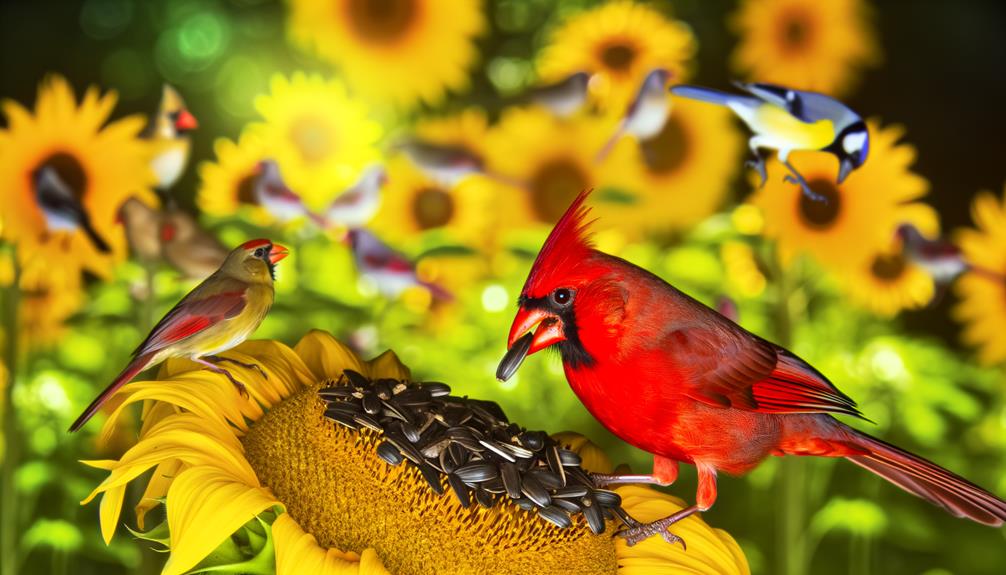
Among the various food sources that cater to the nutritional needs of cardinals, black oil sunflower seeds stand out due to their high fat and protein content, which are essential for energy provision and muscle maintenance.
These seeds are particularly beneficial because they possess a thinner shell compared to other sunflower seed variants, making them easier for cardinals to crack open.
Additionally, the high caloric density of black oil sunflower seeds ensures that cardinals can sustain their energy levels, especially during periods of increased activity.
The oil content in these seeds is also rich in essential fatty acids, which play a vital role in maintaining the overall health of the birds' plumage and skin, thereby enhancing their resilience to environmental stressors.
Seasonal Variations in Diet
The dietary preferences of cardinals exhibit significant seasonal changes, influenced by the availability of different food sources and the birds' changing nutritional needs throughout the year. During the spring and summer, cardinals mainly consume insects, which provide essential proteins for breeding and raising their young.
As the seasons shift to autumn and winter, their diet changes mainly to seeds and fruits, which are more abundant and offer the necessary energy reserves to endure colder temperatures. Importantly, black oil sunflower seeds become a vital component of their diet during these colder months due to their high fat content.
Understanding these seasonal dietary shifts is crucial for those aiming to support cardinal populations through targeted feeding strategies.
Seed Types Cardinals Favor
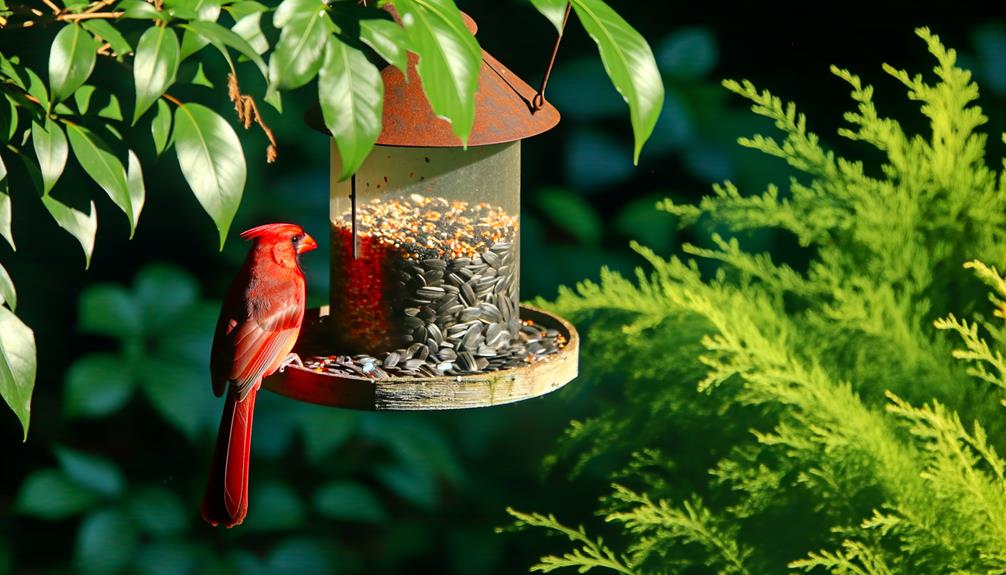
Cardinals exhibit specific preferences when it comes to seed types. They favor black oil sunflower seeds due to their high oil content and nutritional value.
Additionally, the seasonal availability of various seeds influences their dietary patterns. Cardinals adjust their consumption based on seed abundance and nutritional needs.
This section will analyze the seed varieties most preferred by cardinals and how these preferences shift with seasonal changes.
Preferred Seed Varieties
Black oil sunflower seeds are particularly favored by cardinals due to their high oil content and thin shells, which provide an excellent source of energy and are easy to crack open.
Cardinals are also known to prefer safflower seeds, which are rich in protein and fat, essential nutrients for their diet.
Additionally, these birds are attracted to white millet and cracked corn, both of which offer substantial caloric benefits.
The preference for these seeds is driven by their nutritional value and ease of consumption. Each seed type's specific attributes cater to the physiological needs of cardinals, enabling them to maintain peak health and energy levels.
Analyzing these preferences reveals a clear alignment between seed characteristics and the dietary requirements of cardinals.
Seasonal Seed Choices
Understanding the preferred seed varieties helps clarify the seasonal seed choices cardinals prefer, as their dietary needs fluctuate with changing environmental conditions.
In winter, cardinals mainly consume high-fat seeds like black oil sunflower seeds due to their caloric density, necessary for energy conservation in colder climates.
Spring introduces a dietary shift where cardinals incorporate a mix of seeds and insects, important for breeding and nurturing their young.
During summer, the availability of insects peaks, yet cardinals continue to consume seeds, albeit in reduced quantities.
Autumn sees a return to seed-heavy diets, including safflower and sunflower seeds, as cardinals build fat reserves for the impending winter.
This cyclical dietary adaptation highlights their reliance on specific seed types throughout the year.
How Cardinals Eat Seeds
With their strong, conical beaks, cardinals efficiently crack open black oil sunflower seeds to access the nutritious kernels inside. This specialized beak morphology allows them to exert significant pressure on the seed shells, facilitating a quick and effective opening process.
Upon cracking the shell, cardinals use their agile tongues to extract the kernel, which they then consume. Their feeding behavior is methodical; they typically hold the seed between their beak and manipulate it until the shell breaks. This precision minimizes waste and maximizes nutritional intake.
Observational studies indicate that cardinals prefer to eat in a perched position, providing stability and better control during the seed-cracking process. This efficient feeding strategy underscores their adaptability and resourcefulness in various habitats.
Attracting Cardinals to Feeders
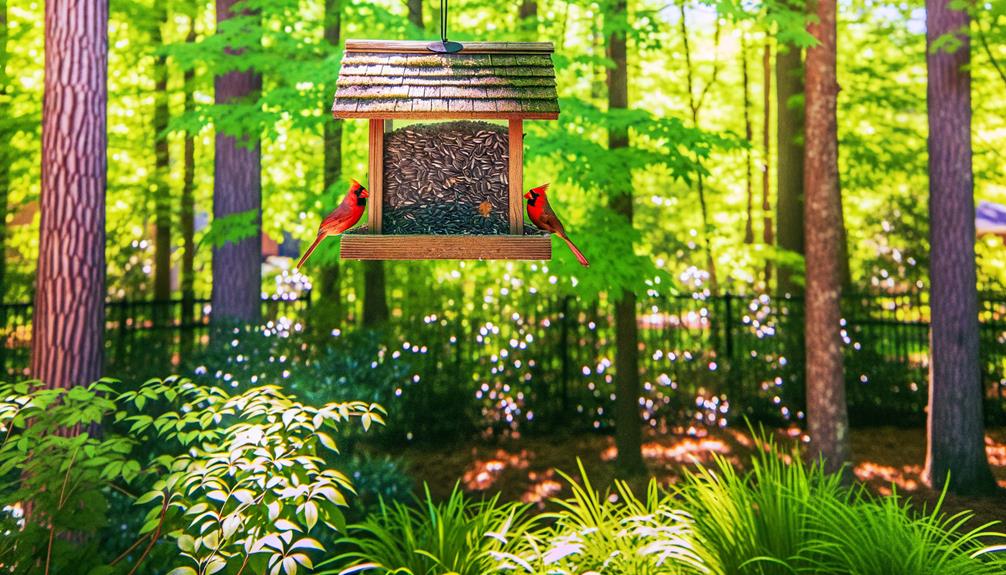
Creating an ideal feeding environment is vital for attracting cardinals to feeders, as it requires a careful selection of feeder design, placement, and food type.
Cardinals prefer feeders that are stable and have ample perching space, ensuring they can comfortably access the food. Placement is essential; situating feeders near dense foliage provides cardinals with necessary cover from predators.
These birds are particularly drawn to black oil sunflower seeds due to their high fat content and thin shells, which are easier to crack open. Additionally, maintaining cleanliness and replenishing food regularly are crucial practices to sustain a healthy feeding area.
Analyzing these factors collectively will enhance the likelihood of attracting cardinals and providing them with a suitable feeding habitat.
Common Feeder Setups
An in-depth analysis of common feeder setups reveals the significance of selecting designs that cater to the feeding habits and physical characteristics of cardinals.
Cardinals, recognized for their sturdy body size and preference for perching rather than clinging, thrive with feeders that provide ample space and stable perches. Hopper feeders and platform feeders are particularly effective, as they accommodate the cardinal's need for a secure footing. Additionally, tube feeders with adjustable or larger perches can also be suitable.
Placement is equally essential; positioning feeders near shrubs or trees offers cardinals a sense of security and quick escape routes. Moreover, ensuring the feeders are within a cardinal's preferred height range, typically four to six feet off the ground, enhances the likelihood of frequent visits.
Other Foods Cardinals Enjoy
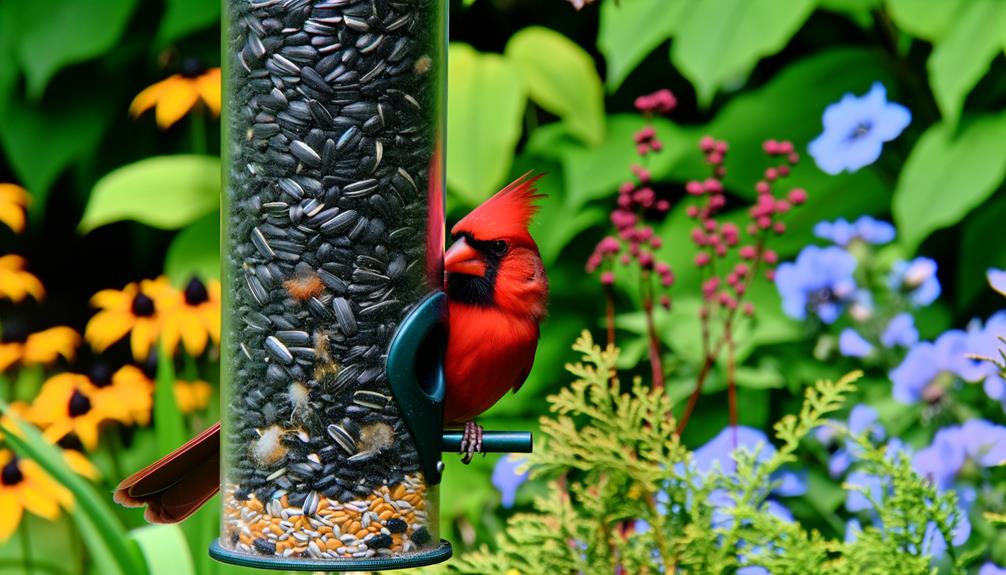
In addition to selecting appropriate feeder setups, understanding the dietary preferences of cardinals is fundamental to attracting and nourishing these vibrant birds. They enjoy a variety of foods beyond black oil sunflower seeds. Cardinals also favor safflower seeds, which are rich in protein and fats, essential for their energy needs.
Moreover, they consume a variety of fruits such as apples, berries, and grapes, which provide essential vitamins and antioxidants. Insects like beetles, caterpillars, and grasshoppers contribute to their protein intake, particularly during the breeding season. Additionally, cardinals are known to eat cracked corn and peanuts, which offer a good source of carbohydrates and fats.
Offering a diverse diet ensures cardinals receive balanced nutrition for optimal health and vitality.
Potential Dietary Risks
While black oil sunflower seeds are a favorite among cardinals, potential dietary risks such as nutritional imbalances must be considered, as a diet overly reliant on these seeds can lack essential nutrients.
Additionally, the risk of mold and contamination in improperly stored seeds poses significant health hazards.
Nutritional Imbalance Concerns
Examining the potential dietary risks, one primary concern is that an over-reliance on black oil sunflower seeds may lead to nutritional imbalances in cardinals. These seeds, while rich in fats and calories, lack essential nutrients such as proteins, vitamins, and minerals that are crucial for avian health.
An imbalanced diet can result in deficiencies, impacting the bird's immune system, feather quality, and overall well-being. Additionally, excessive fat intake from these seeds can contribute to obesity and related health issues.
It is crucial for those feeding wild cardinals to guarantee a diverse food supply, incorporating a variety of seeds, fruits, and insects to meet the complete nutritional needs of these birds and promote their peak health.
Mold and Contamination Risks
Another significant dietary risk associated with feeding cardinals black oil sunflower seeds is the potential for mold growth and contamination, which can lead to serious health issues. Mold spores thrive in damp conditions, and improperly stored seeds can become a breeding ground for these harmful microorganisms. Contamination with mycotoxins, toxic compounds produced by certain molds, poses a severe threat to avian health.
Key risks include:
- Aflatoxicosis: Mycotoxins such as aflatoxins can cause liver damage, immune suppression, and ultimately, mortality in cardinals.
- Nutritional Degradation: Mold contamination can degrade the nutritional value of seeds, depriving birds of essential nutrients.
- Respiratory Issues: Inhalation of mold spores can lead to respiratory infections, compromising the health of cardinals.
Ensuring proper storage and regular inspection of seeds can mitigate these risks.
Overeating Health Issues
Overindulging in black oil sunflower seeds can lead to a range of health issues in cardinals, including obesity, nutrient imbalances, and related metabolic disorders. Excessive consumption of these seeds, while a rich source of fats and proteins, can displace other essential nutrients in their diet, such as vitamins and minerals found in fruits and insects.
This imbalance can precipitate deficiencies that impair physiological functions and immune responses. Additionally, the high-fat content of black oil sunflower seeds can contribute to adiposity, leading to obesity and associated complications like cardiovascular strain and reduced mobility.
Consequently, a balanced diet, incorporating a variety of food sources, is crucial to mitigate these risks and safeguard the overall health and longevity of cardinals.
Observing Cardinal Feeding Habits
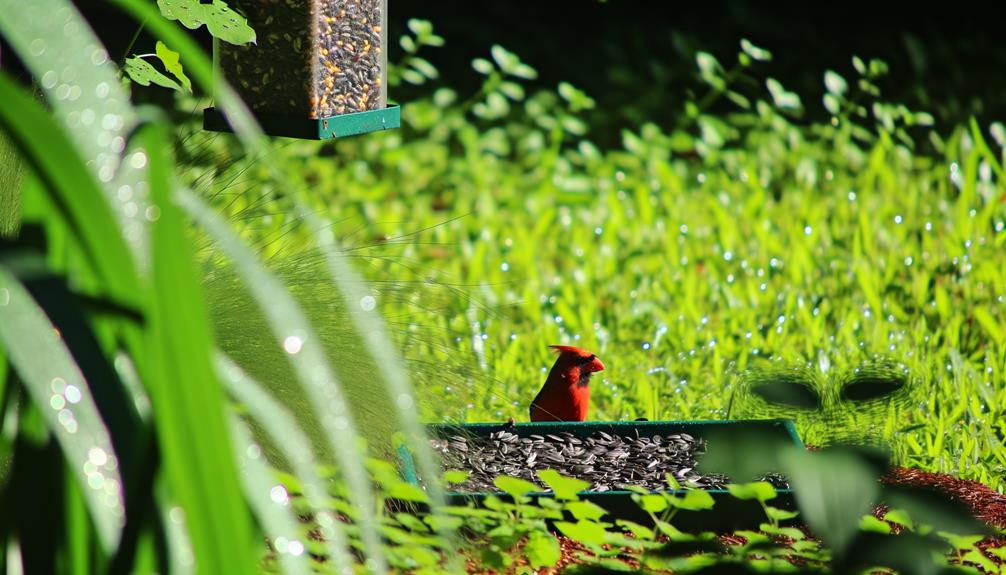
Observing the feeding habits of cardinals reveals a distinct preference for black oil sunflower seeds, which provide vital nutrients and energy. These seeds are particularly favored due to their high fat content, thin shells, and ease of consumption.
Behavioral studies have identified several key aspects of cardinal feeding preferences:
- Nutritional Value: Black oil sunflower seeds are rich in fats and proteins, essential for the cardinals' energy-intensive activities such as flight and breeding.
- Feeder Selection: Cardinals are known to frequent feeders that provide an ample supply of black oil sunflower seeds, often returning multiple times throughout the day.
- Seasonal Variations: During colder months, the high-fat content of these seeds becomes even more important, supporting the cardinals' increased metabolic demands.
These observations offer insight into their dietary choices and feeding patterns.
Enhancing Your Backyard for Cardinals
To optimize your backyard for cardinals, selecting ideal feeder types and incorporating native plants are essential strategies.
Tube feeders with wide perches and hopper feeders are particularly effective for accommodating cardinals' feeding preferences.
Additionally, planting native flora such as dogwood and serviceberry can provide natural food sources and shelter, thereby creating an inviting habitat for these birds.
Ideal Feeder Types
Selecting the ideal feeder type is crucial for attracting cardinals to your backyard and guaranteeing they have easy access to black oil sunflower seeds. Cardinals prefer feeders that offer stability and adequate perching space.
Based on scientific observation and analysis, the following feeder types are recommended:
- Platform Feeders: These feeders provide a flat surface, allowing multiple cardinals to feed simultaneously. Their design minimizes seed spillage and supports easy cleaning.
- Hopper Feeders: Featuring an enclosed design, hopper feeders protect seeds from environmental elements. They also offer sufficient perching areas conducive to cardinals' feeding habits.
- Tube Feeders with Trays: Equipped with larger perches or trays, these feeders accommodate cardinals' size and guarantee they can comfortably access seeds without struggle.
Selecting these feeders will enhance the foraging experience for cardinals in your backyard.
Native Plant Selection
How can the strategic selection of native plants greatly enhance your backyard habitat to attract and sustain vibrant populations of cardinals? Native plants provide essential resources such as food, shelter, and nesting sites, tailored to the ecological needs of cardinals. By integrating a variety of native flora, you can create a supportive environment that promotes cardinal health and breeding success.
| Plant Type | Example Species | Benefits to Cardinals |
|---|---|---|
| Trees | Dogwood, Oak | Provide shelter, nesting sites |
| Shrubs | Serviceberry, Holly | Offer berries and cover |
| Flowering Plants | Coneflower, Aster | Attract insects for food |
This selection not only supports cardinals but also enriches local biodiversity, fostering a balanced and resilient ecosystem.
Conclusion
The crimson cardinal, a symbol of importance and resilience, thrives on a diet that includes black oil sunflower seeds, which meet its nutritional needs. These seeds, rich in necessary fats and proteins, offer sustenance, especially during challenging winters when food is scarce.
While cardinals exhibit diverse dietary preferences, black oil sunflower seeds remain a staple. Therefore, offering these seeds can transform a backyard into a sanctuary, nurturing the cardinal's vibrant presence and ensuring its continued survival.






